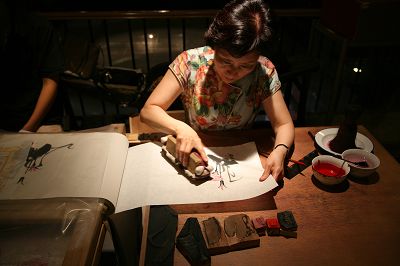Skill preservation key to watercolor block print legacy

The process of watercolor block printing is complicated and delicate. Painting, carving and printing techniques are used to reproduce the charm of Chinese ink paintings.
Early forms of printing originated in China and can be divided into three major types—woodblock printing, movable-type printing and overprinting. Watercolor block printing is an ancient form of Chinese color block printing used by the Han ethnic group. It is also known as multicolor overprinting and embossing. Watercolor block printing includes methods of painting, carving and printing to reproduce ink paintings on the basis of ink permeation.
The process is complicated and delicate. The first step of watercolor block printing is separating and tracing. Painters separate the pictures into different layers based on their colors, depth and shades, and they trace these different elements. Then they transfer each layer onto the tracing paper. The second process is carving. Craftsmen try to reproduce the element of the tracing paper on the woodblock using knives, and the knives, just like the paintbrushes, reflecting the tone of the original painting. The last process is to utilize each woodblock to realize overprinting.
Historians generally believe that the print Monk Wuwen’s Annotation of the Diamond Sutra by the Zifu Temple in Zhongxinglu, today’s Jiangling, Hubei Province, in 1340 is the earliest example of an overprinting product. However, Xiao Dongfa, director of the Modern Publishing Institute and professor of School of Journalism and Communication at Peking University, insists that the origins of overprinting date back much earlier and overprinting techniques were first used during the Song (960-1279) and Liao (907-1125) dynasties, which is around when movable-type printing is believed to have originated.
Time changes, but the skills used in watercolor block printing still exist and have continued to develop. Watercolor block printing developed significantly in the Ming Dynasty (1368-1644), and craftsmen utilized multiple colors and woodblocks to print many famous ink paintings. Rongbaozhai, or the Studio of Glorious Treasures, applied techniques of multicolor overprinting and embossing to print the Night Revels of Han Xizai in Beijing at that time. The Night Revels of Han Xizai required thousands of woodblocks as part of its overprinting process, which demonstrated that Chinese woodblock techniques in the late Ming Dynasty had developed rapidly.
The duplicates of ancient Chinese paintings via watercolor block printing are often indistinguishable from originals. Because of the craftsmanship, delicate materials and complicated processes involved, the market price for these duplicates is quite high. Wang Zhijiang, a professor of the Department of Communication at the Faculty of Arts at Nankai University, indicated that he believes woodblock New Year paintings evolved from works of watercolor block printing, which cost less and average people could afford. The popularization of woodblock New Year painting may have exerted an influence on this. People can easily access woodblock New Year paintings, and this has ensured woodblock prints will continue to be passed down through generations.
Although woodblock New Year paintings are relatively cheap, their artistic value is obvious. Multicolored woodblock New Year paintings not only represent Chinese people’s love for folk customs and festivals, but can also reflect ordinary people’s living conditions, cultural and geographical environment, and the pursuit of a better life.
